Effect of Silica Fume on Engineering Performance and Life Cycle Impact of Jute-Fibre-Reinforced Concrete
Abstract
1. Introduction
2. Materials and Methods
2.1. Constituent Materials
2.2. Design and Preparation of Concrete Mixtures
2.3. Determination of Concrete Properties or Engineering Performance
2.4. Life Cycle Assessment or Environmental Performance
3. Results and Discussion
3.1. Engineering Performance
3.1.1. Air Content
3.1.2. Fresh Density
3.1.3. Slump
3.1.4. Compressive Strength
3.1.5. Splitting Tensile Strength
3.1.6. Load versus Deflection
3.1.7. Flexural Strength or Modulus of Rupture
3.1.8. Residual Strength and Flexural Toughness
3.1.9. Water Absorption Capacity
3.1.10. Rapid Chloride Ion Permeability
3.1.11. Ultrasonic Pulse Velocity
3.1.12. Electrical Resistivity
3.2. Life Cycle Assessment Results
4. Conclusions
- The inclusion of JF is harmful to the workability, and it increased the air content of the fresh concrete. The use of SF can be helpful in improving the fresh density and air content of fresh JFRC mixtures.
- The addition of 0.3% JF resulted in an overall improvement in compressive strength of 5–10%. The combination of 10% SF and 0.3% JF led to a remarkable improvement of 26.5% and 30.6%, respectively, compared to the control sample.
- The addition of SF in the binder further improved the STS gain from adding fibre. When a 0.3% JF volume and 10% SF were added, the STS increased by 32% and 37%, respectively, compared to the control sample.
- The increase in JF content improved the overall flexural response of the concrete. The flexural ductility and post-peak deflection behaviour were improved with the increase in the JF content from 0.3% to 0.5%. JFRCs with high fibre content also showed notable yielding before experiencing the strain-softening response.
- The best improvements in both STS and FS were achieved with a 0.5% JF dosage, but the difference in the net improvement between 0.3% JF and 0.5% JF was not significant. Therefore, it can be concluded that a 0.3% JF dosage is optimal in terms of both mechanical and economic performance.
- At both 28 and 91 days, the addition of 0.5% JF and 10% SF increased the FS of the concrete by 27% and 32%, respectively. The inclusion of 0.5% JF improved the FT of the concrete by 6.4-times and 7.3-times with 0% and 10% SF addition, respectively.
- Increasing the volume of JF from 0.15% to 0.5% resulted in a 16.5% increase in the water absorption (WA) capacity of the concrete. The addition of SF helped JFRCs achieve lower WA values compared to the control concrete.
- JFRCs showed a higher level of RCIP compared to the control concrete, regardless of the fibre content. Nonetheless, the incorporation of SF helped to decrease the chloride permeability in JFRCs. This is likely due to the additional growth of C-S-H and micro-filler action, which intercept the movement of chloride ions within the microstructure of JFRCs.
- The UPV findings indicated that the density of JFRCs is lower than that of traditional concrete, which could be attributed to the presence of light-density and porous fibres. Nonetheless, incorporating SF can enhance the quality of JFRCs and result in a superior final product.
- The study found that the risk of corrosion in JFRCs increased with higher volumes of JF, and incorporating 0.5% JF resulted in a 40% reduction in electrical resistivity (ER). However, adding SF significantly improved the ER of JFRCs.
- The use of JF is slightly useful in reducing the volume-related emissions of concrete. However, it can cause significant reductions in STS and FS-related emissions. Up to a 30% net reduction in the STS-related emissions was observed due to the addition of 0.5% JF and 10% SF.
Funding
Institutional Review Board Statement
Informed Consent Statement
Data Availability Statement
Conflicts of Interest
References
- Afroughsabet, V.; Biolzi, L.; Ozbakkaloglu, T. High-performance fiber-reinforced concrete: A review. J. Mater. Sci. 2016, 51, 6517–6551. [Google Scholar] [CrossRef]
- Mardalizad, A.; Caruso, M.; Manes, A.; Giglio, M. Investigation of mechanical behaviour of a quasi-brittle material using Karagozian and Case concrete (KCC) model. J. Rock Mech. Geotech. Eng. 2019, 11, 1119–1137. [Google Scholar] [CrossRef]
- Lee, G.-W.; Choi, Y.-C. Effect of abaca natural fiber on the setting behavior and autogenous shrinkage of cement composite. J. Build. Eng. 2022, 56, 104719. [Google Scholar] [CrossRef]
- Hashmi, A.F.; Shariq, M.; Baqi, A. An investigation into age-dependent strength, elastic modulus and deflection of low calcium fly ash concrete for sustainable construction. Constr. Build. Mater. 2021, 283, 122772. [Google Scholar] [CrossRef]
- Afroughsabet, V.; Biolzi, L.; Monteiro, P.J.M. The effect of steel and polypropylene fibers on the chloride diffusivity and drying shrinkage of high-strength concrete. Compos. Part B Eng. 2018, 139, 84–96. [Google Scholar] [CrossRef]
- Gulzar, M.A.; Ali, B.; Barakat, O.; Azab, M.; Najemalden, A.M.; Salih Mohammed, A.; Alashker, Y. Influence of Jute Fiber on Tensile, Electrical, and Permeability Characteristics of Slag Concrete: A Better, Cheaper, and Eco-Friendly Substitute for Conventional Concrete. J. Nat. Fibers 2023, 20, 2170947. [Google Scholar] [CrossRef]
- Ali, B.; Fahad, M.; Ullah, S.; Ahmed, H.; Alyousef, R.; Deifalla, A. Development of Ductile and Durable High Strength Concrete (HSC) through Interactive Incorporation of Coir Waste and Silica Fume. Materials 2022, 15, 2616. [Google Scholar] [CrossRef]
- Lao, J.-C.; Huang, B.-T.; Xu, L.-Y.; Khan, M.; Fang, Y.; Dai, J.-G. Seawater sea-sand Engineered Geopolymer Composites (EGC) with high strength and high ductility. Cem. Concr. Compos. 2023, 138, 104998. [Google Scholar] [CrossRef]
- Khan, M.; Cao, M.; Ai, H.; Hussain, A. Basalt Fibers in Modified Whisker Reinforced Cementitious Composites. Period. Polytech. Civ. Eng. 2022, 66, 344–354. [Google Scholar] [CrossRef]
- Khan, M.; Cao, M.; Xie, C.; Ali, M. Hybrid fiber concrete with different basalt fiber length and content. Struct. Concr. 2022, 23, 346–364. [Google Scholar] [CrossRef]
- El Ouni, M.H.; Shah, S.H.A.; Ali, A.; Muhammad, S.; Mahmood, M.S.; Ali, B.; Marzouki, R.; Raza, A. Mechanical performance, water and chloride permeability of hybrid steel-polypropylene fiber-reinforced recycled aggregate concrete. Case Stud. Constr. Mater. 2022, 16, e00831. [Google Scholar] [CrossRef]
- Ali, B.; Azab, M.; Ahmed, H.; Kurda, R.; El Ouni, M.H.; Elhag, A.B. Investigation of physical, strength, and ductility characteristics of concrete reinforced with banana (Musaceae) stem fiber. J. Build. Eng. 2022, 61, 105024. [Google Scholar] [CrossRef]
- Ali, B.; Kurda, R.; Herki, B.; Alyousef, R.; Mustafa, R.; Mohammed, A.; Raza, A.; Ahmed, H.; Fayyaz Ul-Haq, M. Effect of Varying Steel Fiber Content on Strength and Permeability Characteristics of High Strength Concrete with Micro Silica. Materials 2020, 13, 5739. [Google Scholar] [CrossRef] [PubMed]
- Ali, B.; Qureshi, L.A. Combined Effect of Fly Ash and Glass Fibres on Mechanical Performance of Concrete. NED Univ. J. Res. Mech. 2018, 15, 91–100. [Google Scholar]
- Raza, S.S.; Qureshi, L.A. Effect of carbon fiber on mechanical properties of reactive powder concrete exposed to elevated temperatures. J. Build. Eng. 2021, 42, 102503. [Google Scholar] [CrossRef]
- Raza, S.S.; Qureshi, L.A.; Ali, B.; Raza, A.; Khan, M.M. Effect of different fibers (steel fibers, glass fibers and carbon fibers) on mechanical properties of reactive powder concrete (RPC). Struct. Concr. 2021, 22, 334–346. [Google Scholar] [CrossRef]
- Hussain, I.; Ali, B.; Akhtar, T.; Jameel, M.S.; Raza, S.S. Comparison of mechanical properties of concrete and design thickness of pavement with different types of fiber-reinforcements (steel, glass, and polypropylene). Case Stud. Constr. Mater. 2020, 13, e00429. [Google Scholar] [CrossRef]
- Kizilkanat, A.B.; Kabay, N.; Akyüncü, V.; Chowdhury, S.; Akça, A.H. Mechanical properties and fracture behavior of basalt and glass fiber reinforced concrete: An experimental study. Constr. Build. Mater. 2015, 100, 218–224. [Google Scholar] [CrossRef]
- Ali, B.; Qureshi, L.A.; Kurda, R. Environmental and economic benefits of steel, glass, and polypropylene fiber reinforced cement composite application in jointed plain concrete pavement. Compos. Commun. 2020, 22, 100437. [Google Scholar] [CrossRef]
- Chan, R.; Santana, M.A.; Oda, A.M.; Paniguel, R.C.; Vieira, L.B.; Figueiredo, A.D.; Galobardes, I. Analysis of potential use of fibre reinforced recycled aggregate concrete for sustainable pavements. J. Clean. Prod. 2019, 218, 183–191. [Google Scholar] [CrossRef]
- Khan, M.; Rehman, A.; Ali, M. Efficiency of silica-fume content in plain and natural fiber reinforced concrete for concrete road. Constr. Build. Mater. 2020, 244, 118382. [Google Scholar] [CrossRef]
- Islam, M.S.; Ahmed, S.J.U. Influence of jute fiber on concrete properties. Constr. Build. Mater. 2018, 189, 768–776. [Google Scholar] [CrossRef]
- Onuaguluchi, O.; Banthia, N. Plant-based natural fibre reinforced cement composites: A review. Cem. Concr. Compos. 2016, 68, 96–108. [Google Scholar] [CrossRef]
- Assaedi, H.; Shaikh, F.U.A.; Low, I.M. Characterizations of flax fabric reinforced nanoclay-geopolymer composites. Compos. Part B Eng. 2016, 95, 412–422. [Google Scholar] [CrossRef]
- Satyanarayana, K.G.; Sukumaran, K.; Mukherjee, P.S.; Pavithran, C.; Pillai, S.G.K. Natural fibre-polymer composites. Cem. Concr. Compos. 1990, 12, 117–136. [Google Scholar] [CrossRef]
- Townsend, T. World natural fibre production and employment. In Handbook of Natural Fibres; Elsevier: Amsterdam, The Netherlands, 2020; pp. 15–36. [Google Scholar]
- Affan, M.; Ali, M. Experimental investigation on mechanical properties of jute fiber reinforced concrete under freeze-thaw conditions for pavement applications. Constr. Build. Mater. 2022, 323, 126599. [Google Scholar] [CrossRef]
- Zakaria, M.; Ahmed, M.; Hoque, M.M.; Islam, S. Scope of using jute fiber for the reinforcement of concrete material. Text. Cloth. Sustain. 2016, 2, 11. [Google Scholar] [CrossRef]
- Zakaria, M.; Ahmed, M.; Hoque, M.; Shaid, A. A comparative study of the mechanical properties of jute fiber and yarn reinforced concrete composites. J. Nat. Fibers 2020, 17, 676–687. [Google Scholar] [CrossRef]
- Ozawa, M.; Kim, G.-Y.; Choe, G.-C.; Yoon, M.-H.; Sato, R.; Rokugo, K. Thermal properties of jute fiber concrete at high temperature. J. Struct. Fire Eng. 2016, 7, 182–192. [Google Scholar] [CrossRef]
- Sridhar, J.; Gobinath, R.; Kırgız, M.S. Comparative study for efficacy of chemically treated jute fiber and bamboo fiber on the properties of reinforced concrete beams. J. Nat. Fibers 2022, 19, 12224–12234. [Google Scholar] [CrossRef]
- Teixeira, F.P.; de Andrade Silva, F. On the use of natural curauá reinforced cement based composites for structural applications. Cem. Concr. Compos. 2020, 114, 103775. [Google Scholar] [CrossRef]
- Wei, J.; Meyer, C. Utilization of rice husk ash in green natural fiber-reinforced cement composites: Mitigating degradation of sisal fiber. Cem. Concr. Res. 2016, 81, 94–111. [Google Scholar] [CrossRef]
- ASTM-C150; Standard Specification for Portland Cement. ASTM International: West Conshohocken, PA, USA, 2018.
- Ren, G.; Yao, B.; Huang, H.; Gao, X. Influence of sisal fibers on the mechanical performance of ultra-high performance concretes. Constr. Build. Mater. 2021, 286, 122958. [Google Scholar] [CrossRef]
- ASTM-C231; Testing Air Content of Concrete with a Type B Pressure Meter. ASTM International: West Conshohocken, PA, USA, 2003.
- ASTM-C143; Standard Test Method for Slump of Hydraulic-Cement Concrete. ASTM International: West Conshohocken, PA, USA, 2015.
- ASTM-C39; Standard Test Method for Compressive Strength of Cylindrical Concrete Specimens. ASTM International: West Conshohocken, PA, USA, 2015.
- ASTM-C496; Standard Test Method for Splitting Tensile Strength of Cylindrical Concrete Specimens. ASTM International: West Conshohocken, PA, USA, 2017.
- ASTM-C1609; Standard Test Method for Flexural Performance of Fiber-Reinforced Concrete (Using Beam with Third-Point Loading). ASTM International: West Conshohocken, PA, USA, 2019.
- ASTM-C948; Standard Test Method for Dry and Wet Bulk Density, Water Absorption, and Apparent Porosity of Thin Sections of Glass-Fiber Reinforced Concrete. ASTM International: West Conshohocken, PA, USA, 2016.
- ASTM C1202-19; Standard Test Method for Electrical Indication of Concrete’s Ability to Resist Chloride Ion Penetration. ASTM International: West Conshohocken, PA, USA, 2012.
- ASTM C1876-19; Standard Test Method for Bulk Electrical Resistivity or Bulk Conductivity of Concrete. ASTM International: West Conshohocken, PA, USA, 2019.
- ASTM C597-16; Standard Test Method for Pulse Velocity Through Concrete. ASTM International: West Conshohocken, PA, USA, 2016.
- Kurda, R.; Silvestre, J.D.; de Brito, J. Life cycle assessment of concrete made with high volume of recycled concrete aggregates and fly ash. Resour. Conserv. Recycl. 2018, 139, 407–417. [Google Scholar] [CrossRef]
- Hájek, P.; Fiala, C.; Kynčlová, M. Life cycle assessments of concrete structures—A step towards environmental savings. Struct. Concr. 2011, 12, 13–22. [Google Scholar] [CrossRef]
- Shah, S.H.A.; Amir, M.T.; Ali, B.; El Ouni, M.H. Mechanical performance and environmental impact of normal strength concrete incorporating various levels of coconut fiber and recycled aggregates. Environ. Sci. Pollut. Res. 2022, 29, 83636–83651. [Google Scholar] [CrossRef]
- Ali, B.; Farooq, M.A.; El Ouni, M.H.; Azab, M.; Elhag, A.B. The combined effect of coir and superplasticizer on the fresh, mechanical, and long-term durability properties of recycled aggregate concrete. J. Build. Eng. 2022, 59, 105009. [Google Scholar] [CrossRef]
- Kumar, B.G.; Muthu, M.; Chajec, A.; Sadowski, Ł.; Govindaraj, V. The effect of silica fume on the washout resistance of environmentally friendly underwater concrete with a high-volume of siliceous fly ash. Constr. Build. Mater. 2022, 327, 127058. [Google Scholar] [CrossRef]
- Alyousef, R.; Ali, B.; Mohammed, A.; Kurda, R.; Alabduljabbar, H.; Riaz, S. Evaluation of Mechanical and Permeability Characteristics of Microfiber-Reinforced Recycled Aggregate Concrete with Different Potential Waste Mineral Admixtures. Materials 2021, 14, 5933. [Google Scholar] [CrossRef]
- Das, C.S.; Dey, T.; Dandapat, R.; Mukharjee, B.B.; Kumar, J. Performance evaluation of polypropylene fibre reinforced recycled aggregate concrete. Constr. Build. Mater. 2018, 189, 649–659. [Google Scholar] [CrossRef]
- Wu, Z.; Shi, C.; Khayat, K.H. Influence of silica fume content on microstructure development and bond to steel fiber in ultra-high strength cement-based materials (UHSC). Cem. Concr. Compos. 2016, 71, 97–109. [Google Scholar] [CrossRef]
- Yang, Y.; Wu, C.; Liu, Z.; Wang, H.; Ren, Q. Mechanical anisotropy of ultra-high performance fibre-reinforced concrete for 3D printing. Cem. Concr. Compos. 2022, 125, 104310. [Google Scholar] [CrossRef]
- Raza, S.S.; Amir, M.T.; Azab, M.; Ali, B.; Abdallah, M.; El Ouni, M.H.; Elhag, A.B. Effect of micro-silica on the physical, tensile, and load-deflection characteristics of micro fiber-reinforced high-performance concrete (HPC). Case Stud. Constr. Mater. 2022, 17, e01380. [Google Scholar] [CrossRef]
- Razmi, A.; Mirsayar, M.M. On the mixed mode I/II fracture properties of jute fiber-reinforced concrete. Constr. Build. Mater. 2017, 148, 512–520. [Google Scholar] [CrossRef]
- Xie, J.; Huang, L.; Guo, Y.; Li, Z.; Fang, C.; Li, L.; Wang, J. Experimental study on the compressive and flexural behaviour of recycled aggregate concrete modified with silica fume and fibres. Constr. Build. Mater. 2018, 178, 612–623. [Google Scholar] [CrossRef]
- Ali, B.; Raza, S.S.; Kurda, R.; Alyousef, R. Synergistic effects of fly ash and hooked steel fibers on strength and durability properties of high strength recycled aggregate concrete. Resour. Conserv. Recycl. 2021, 168, 105444. [Google Scholar] [CrossRef]
- McDonald, D.B. The Rapid Chloride Permeability Test and Its Correlation to the 90-Day Chloride Ponding Test. PCI J. 1994, 39, 38–47. [Google Scholar]
- Kou, S.; Poon, C.; Agrela, F. Comparisons of natural and recycled aggregate concretes prepared with the addition of different mineral admixtures. Cem. Concr. Compos. 2011, 33, 788–795. [Google Scholar] [CrossRef]
- Qureshi, L.A.; Ali, B.; Ali, A. Combined effects of supplementary cementitious materials (silica fume, GGBS, fly ash and rice husk ash) and steel fiber on the hardened properties of recycled aggregate concrete. Constr. Build. Mater. 2020, 263, 120636. [Google Scholar] [CrossRef]
- BIS 13311-1; Method of Non-Destructive Testing of Concret, Part 1. BIS: Basel, Switzerland, 1992.
- Jena, B.; Patra, R.K.; Mukharjee, B.B. Influence of incorporation of jute fibre and ferrochrome slag on properties of concrete. Aust. J. Civ. Eng. 2022, 20, 13–30. [Google Scholar] [CrossRef]
- Hong, G.; Oh, S.; Choi, S.; Chin, W.-J.; Kim, Y.-J.; Song, C. Correlation between the compressive strength and ultrasonic pulse velocity of cement mortars blended with silica fume: An analysis of microstructure and hydration kinetics. Materials 2021, 14, 2476. [Google Scholar] [CrossRef] [PubMed]
- Adenaert, K. Transport Mechanismen in Zelfverdichtend Beton in Relatie Met Carbonatatie en Chloride Penetratie. Ph.D. Thesis, Ghent University, Ghent, Belgium, 2006. [Google Scholar]
- Afroughsabet, V.; Ozbakkaloglu, T. Mechanical and durability properties of high-strength concrete containing steel and polypropylene fibers. Constr. Build. Mater. 2015, 94, 73–82. [Google Scholar] [CrossRef]
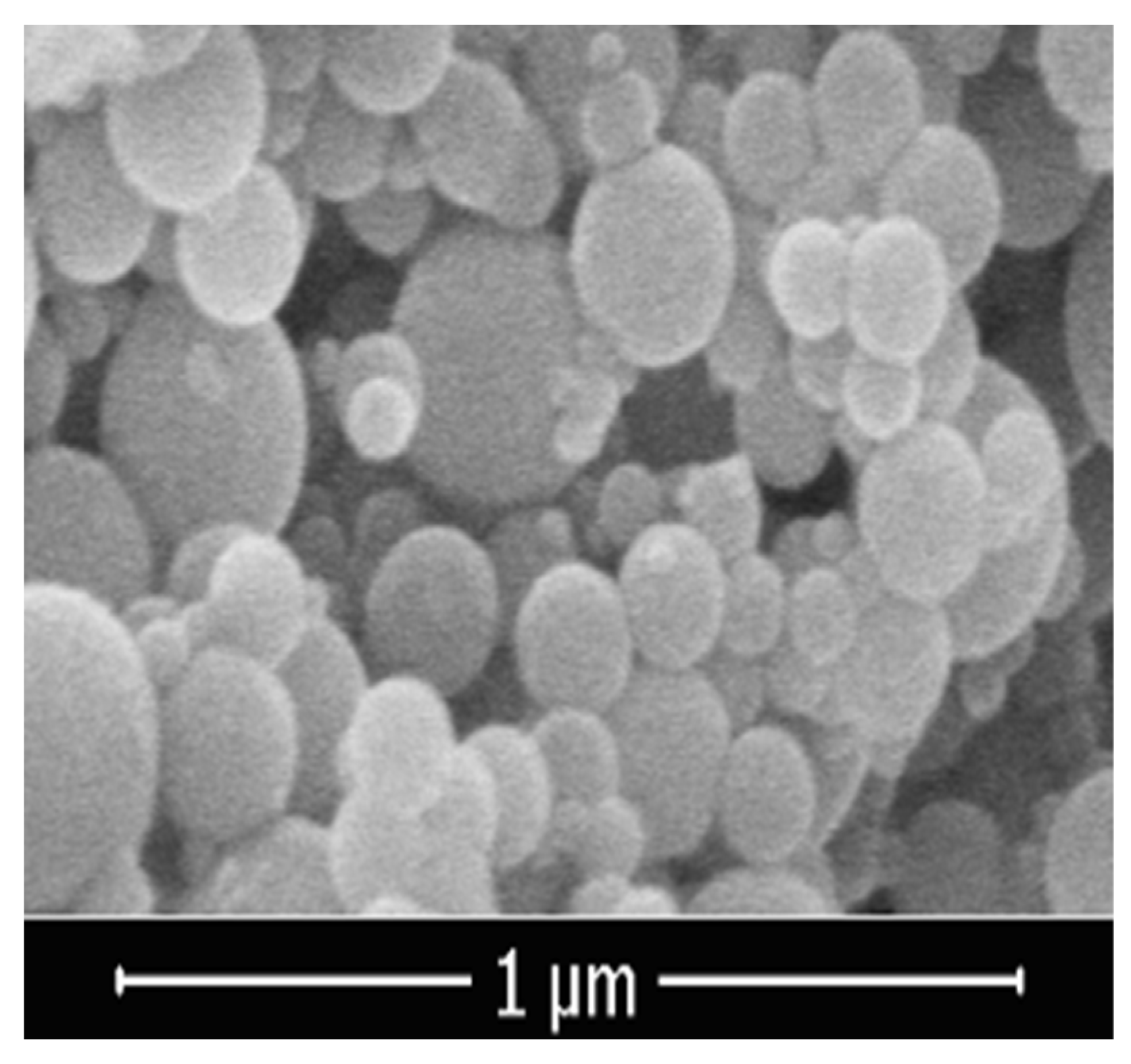
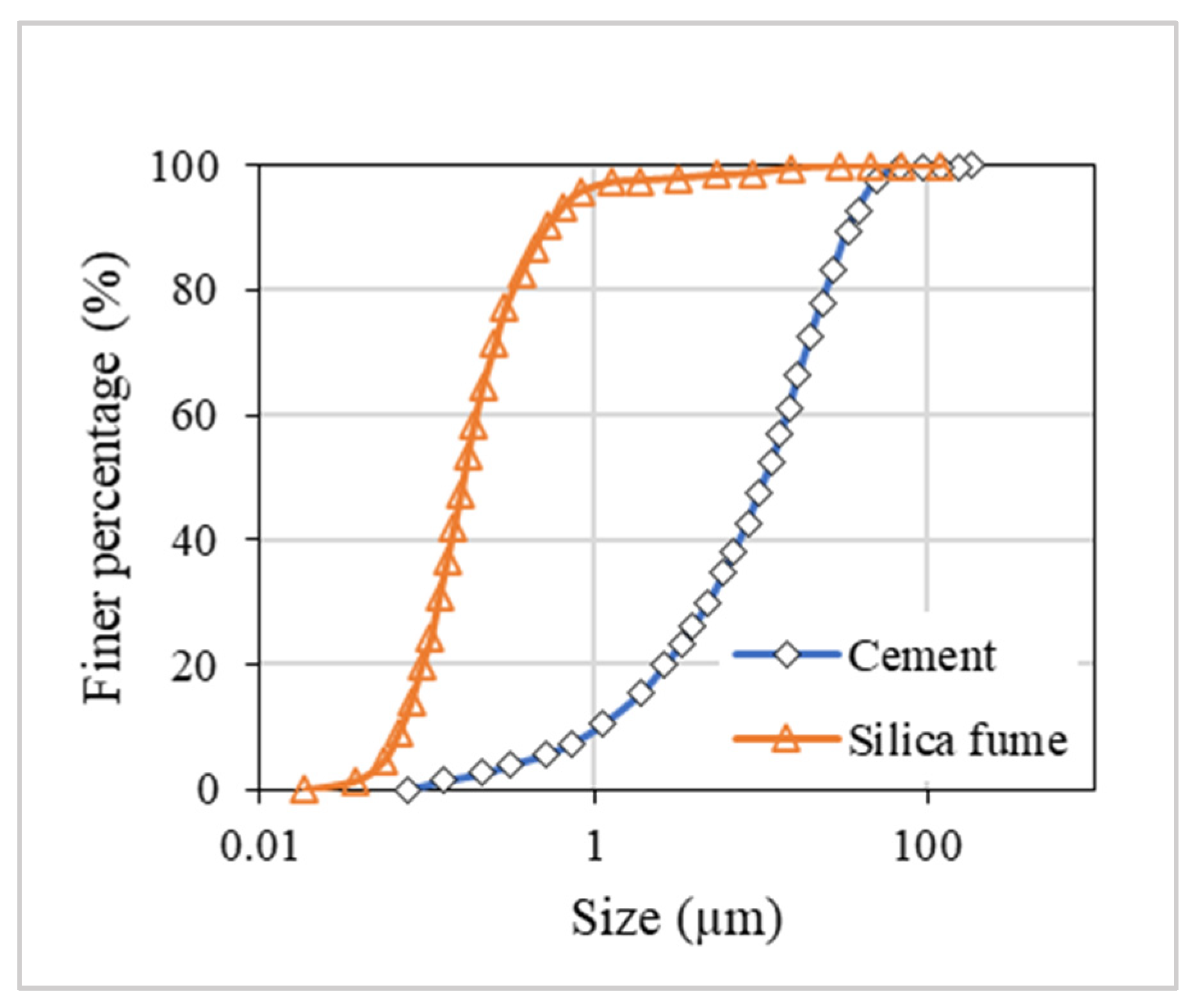

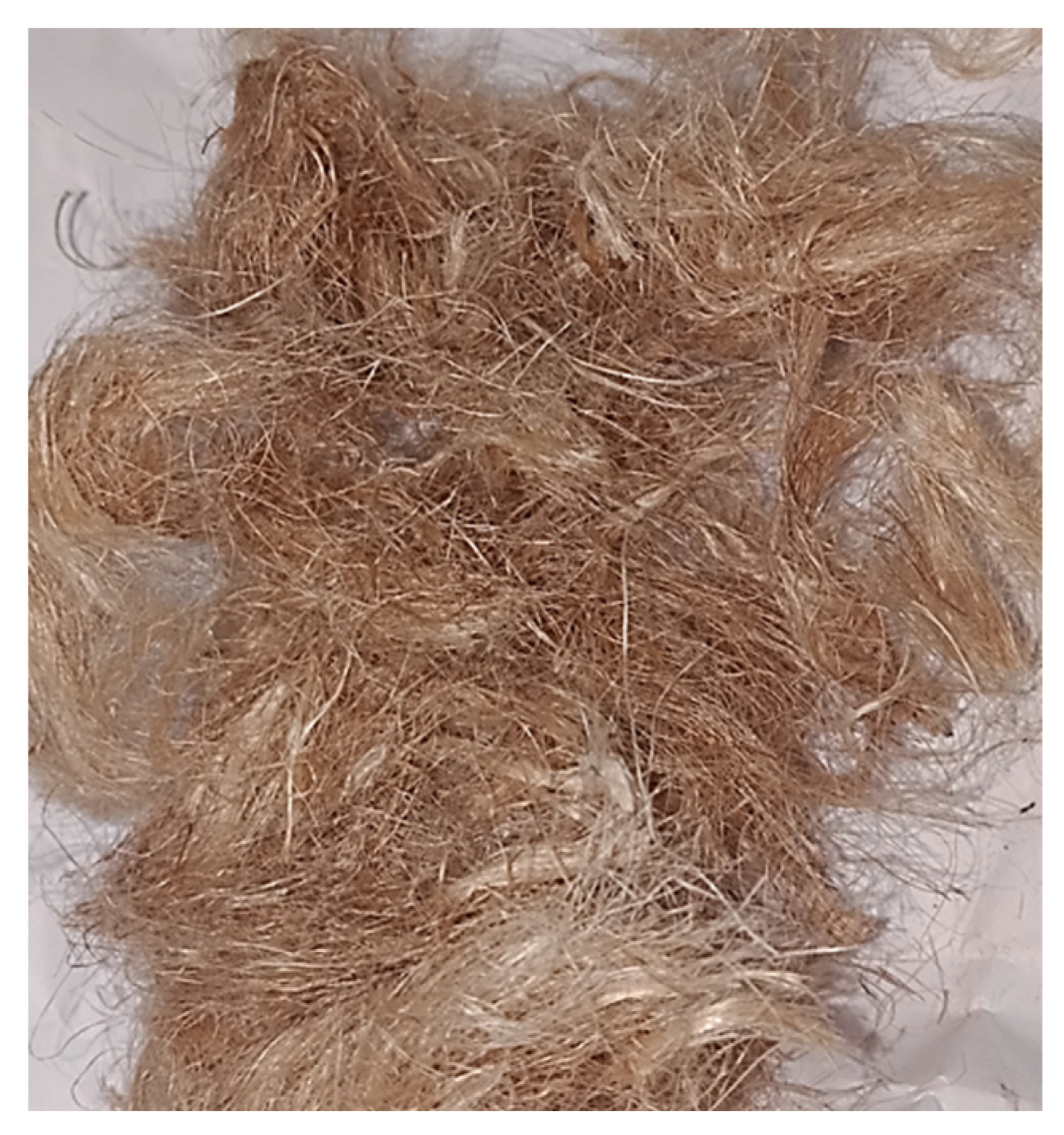
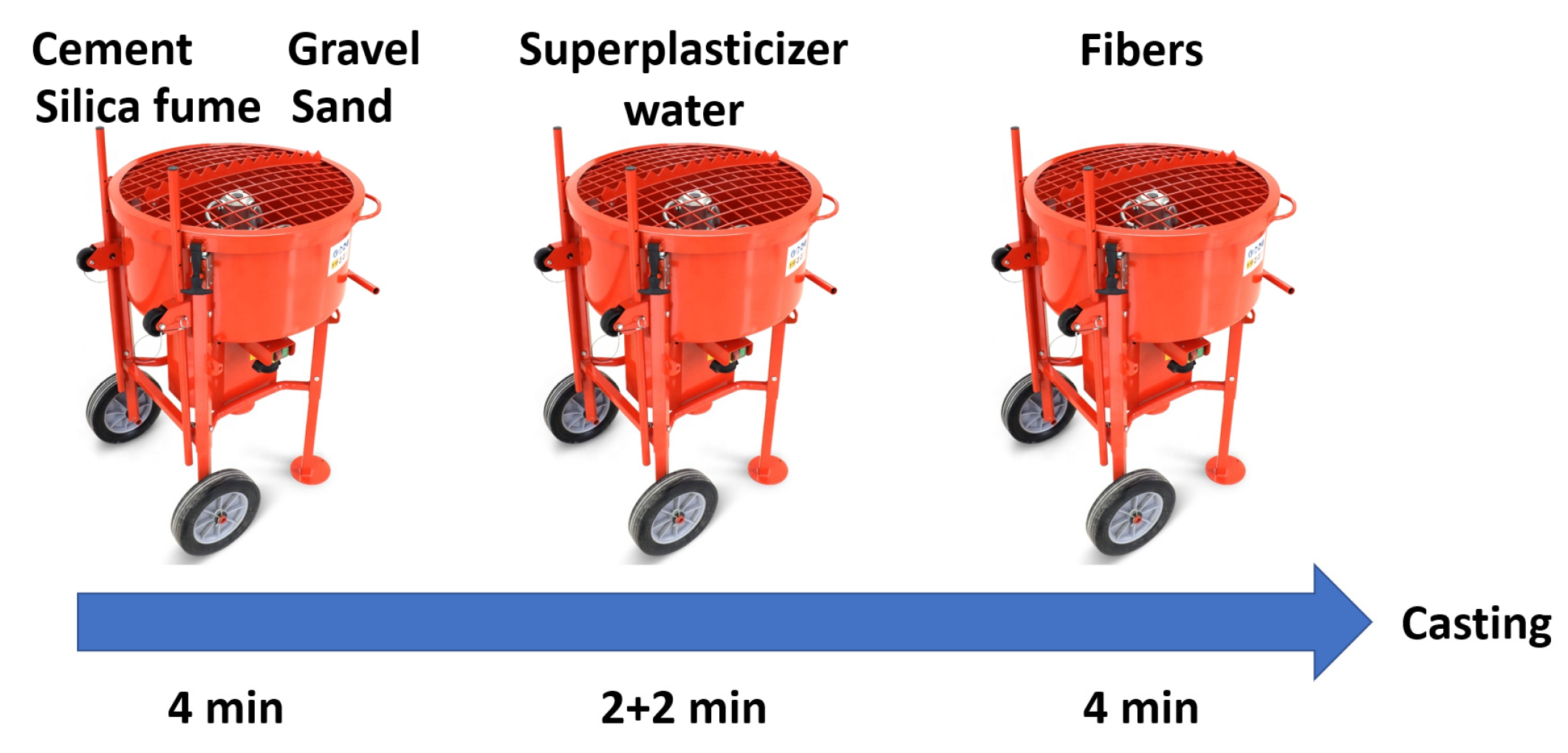
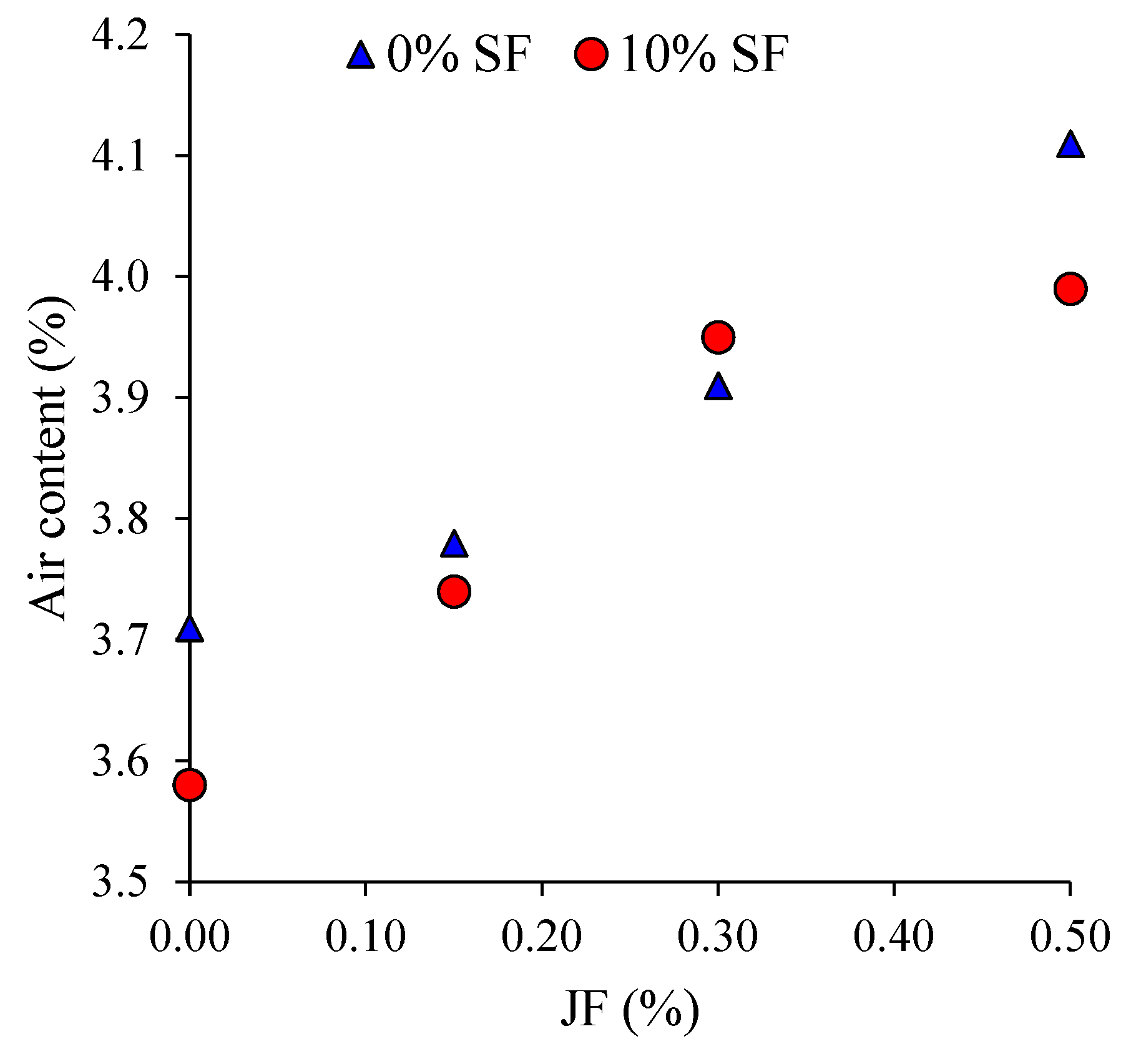

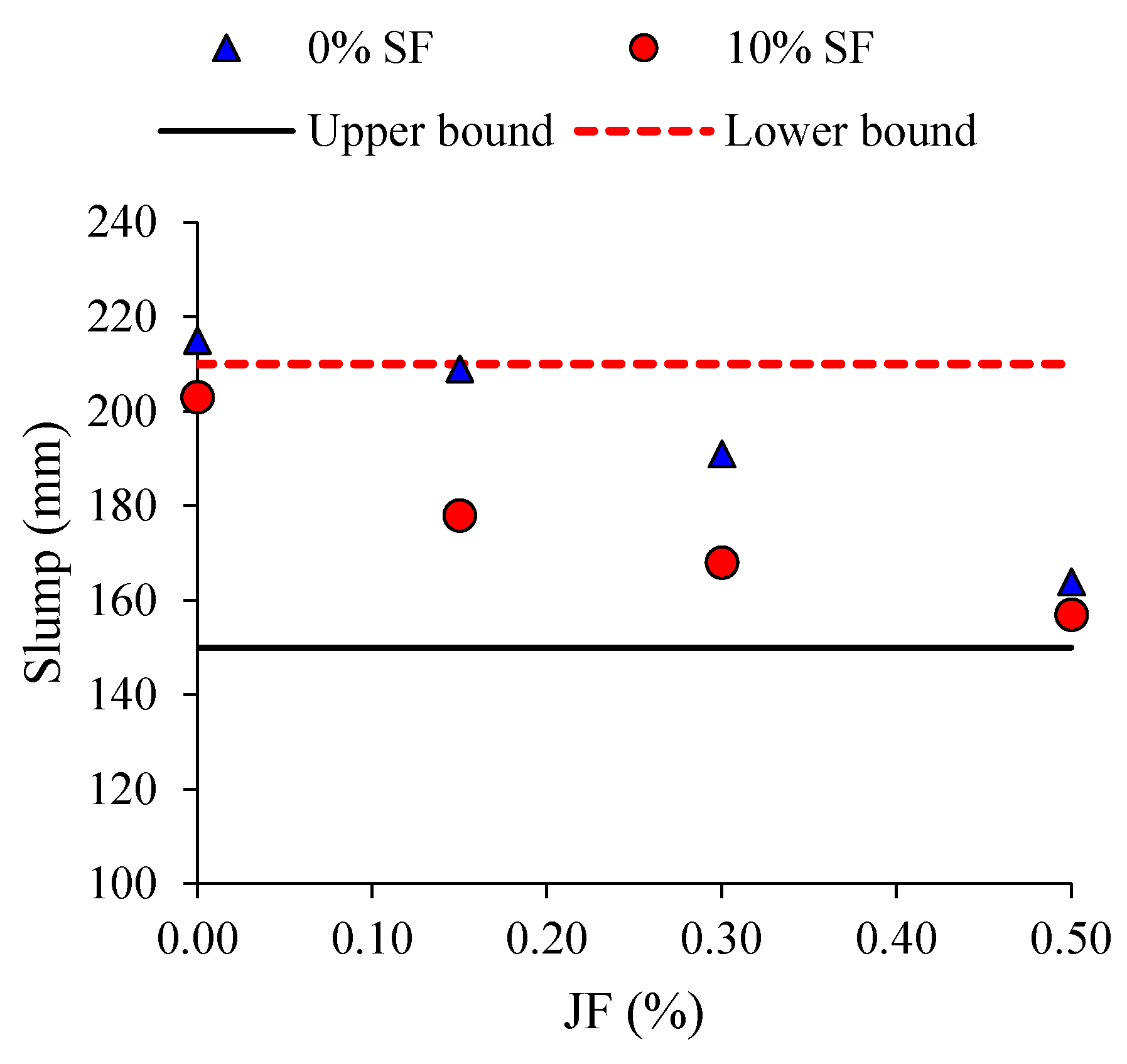
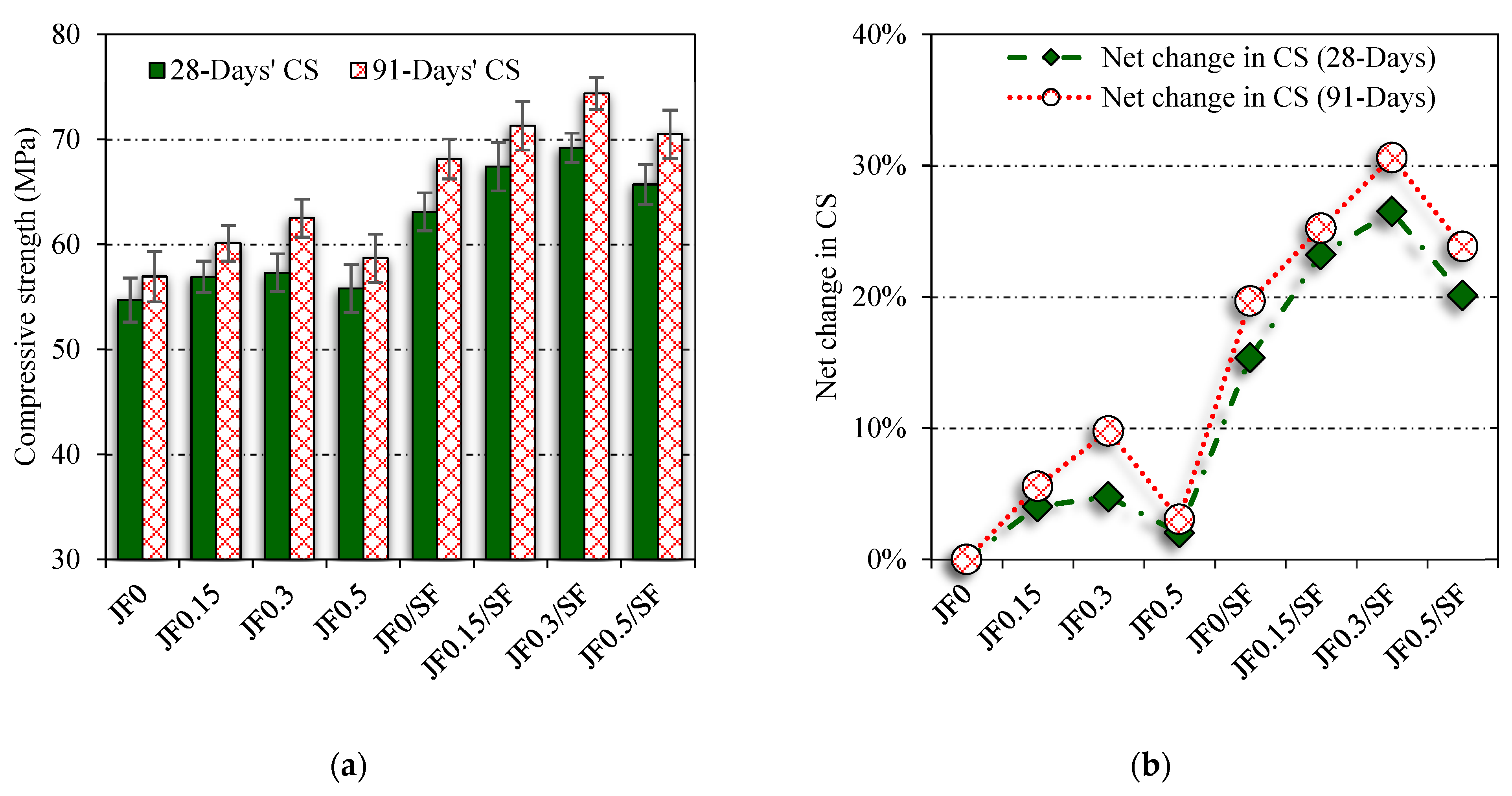
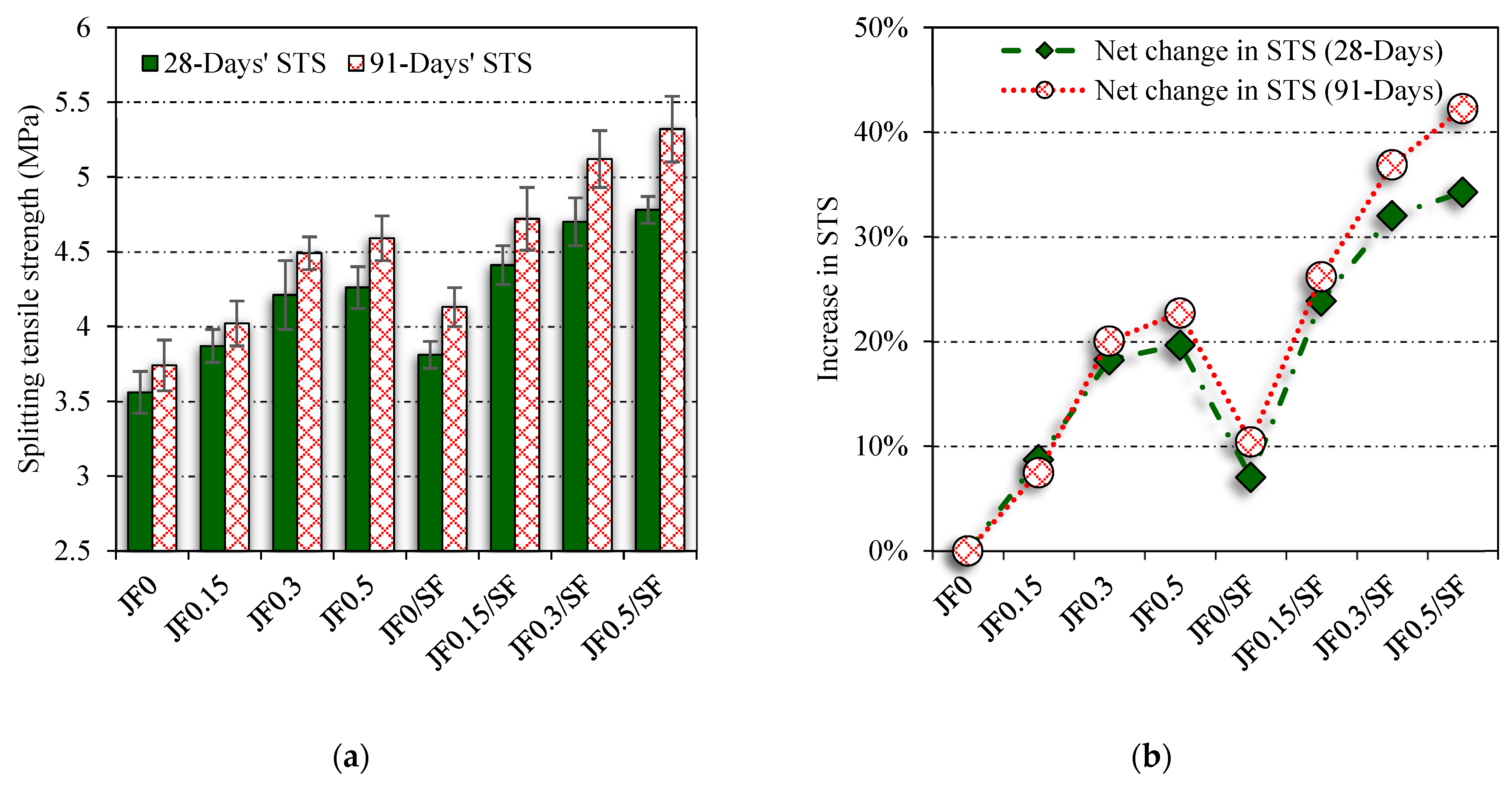
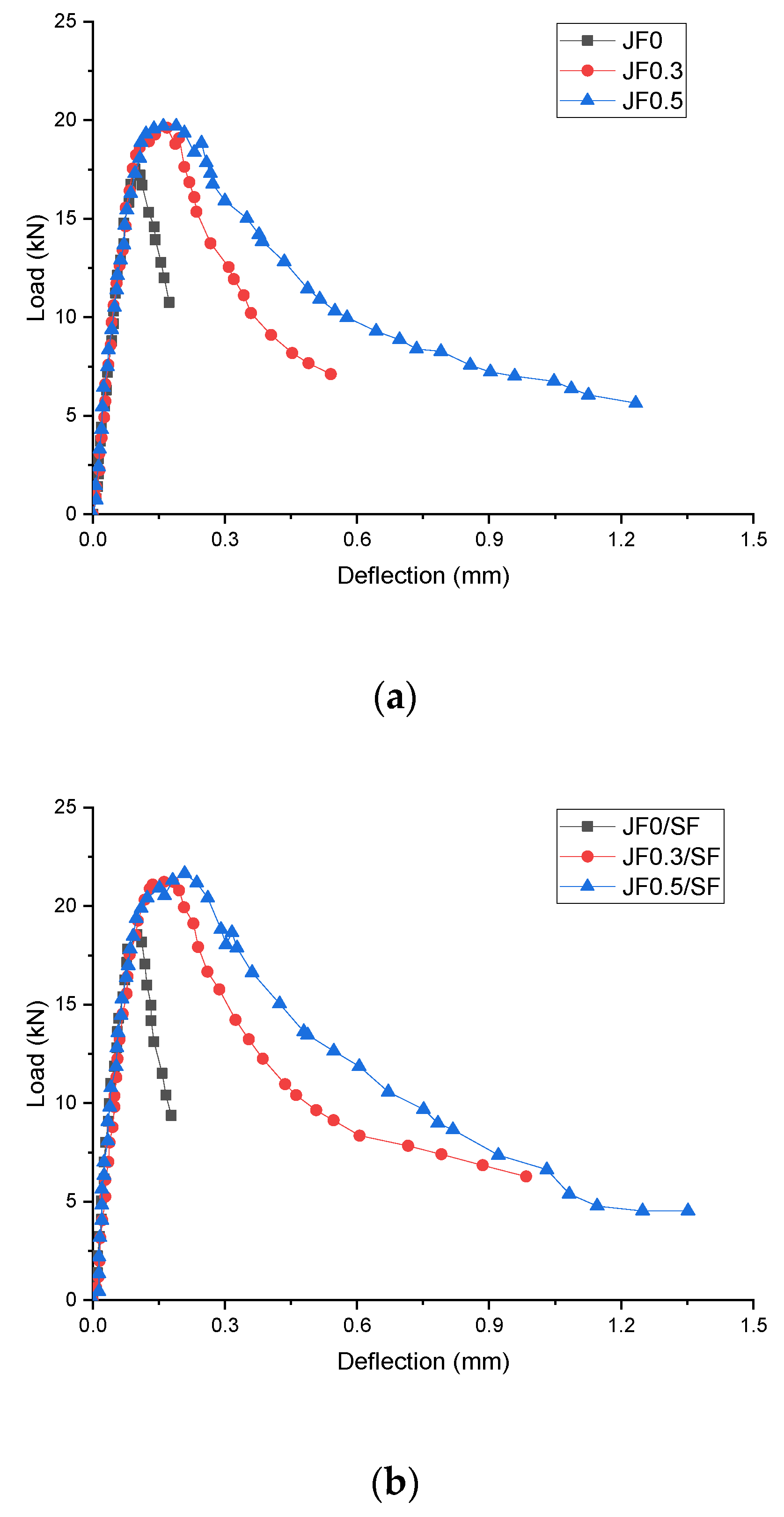

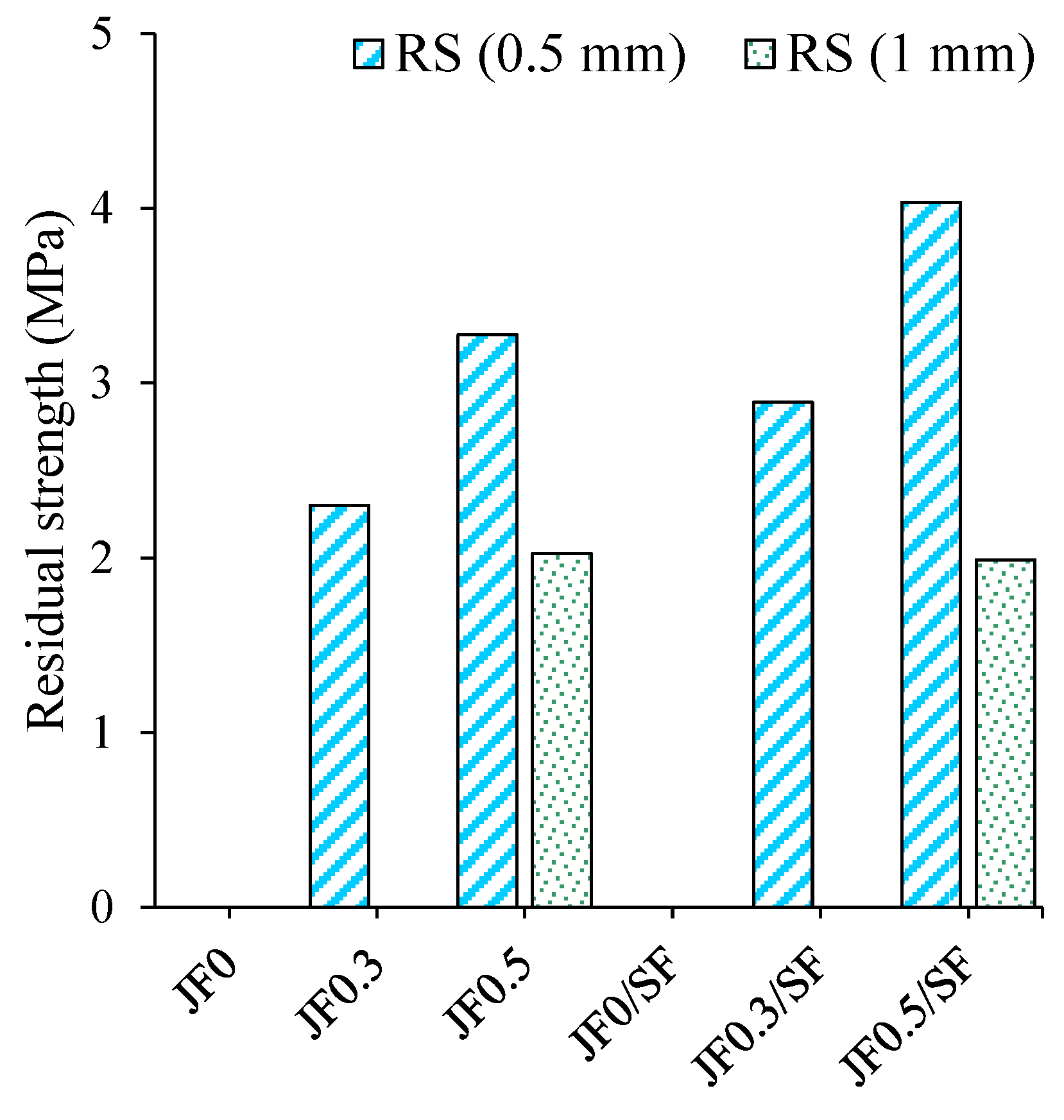
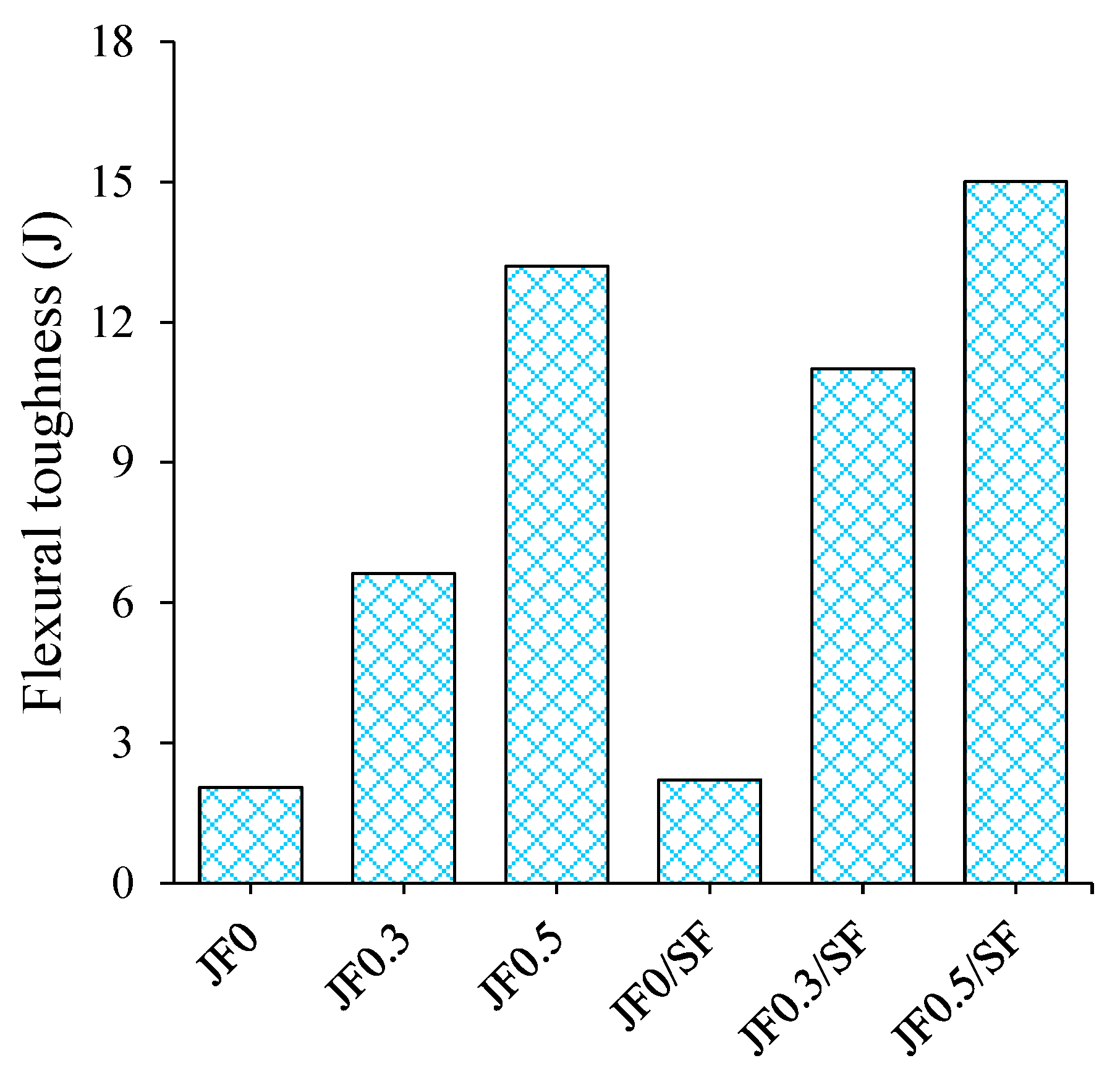
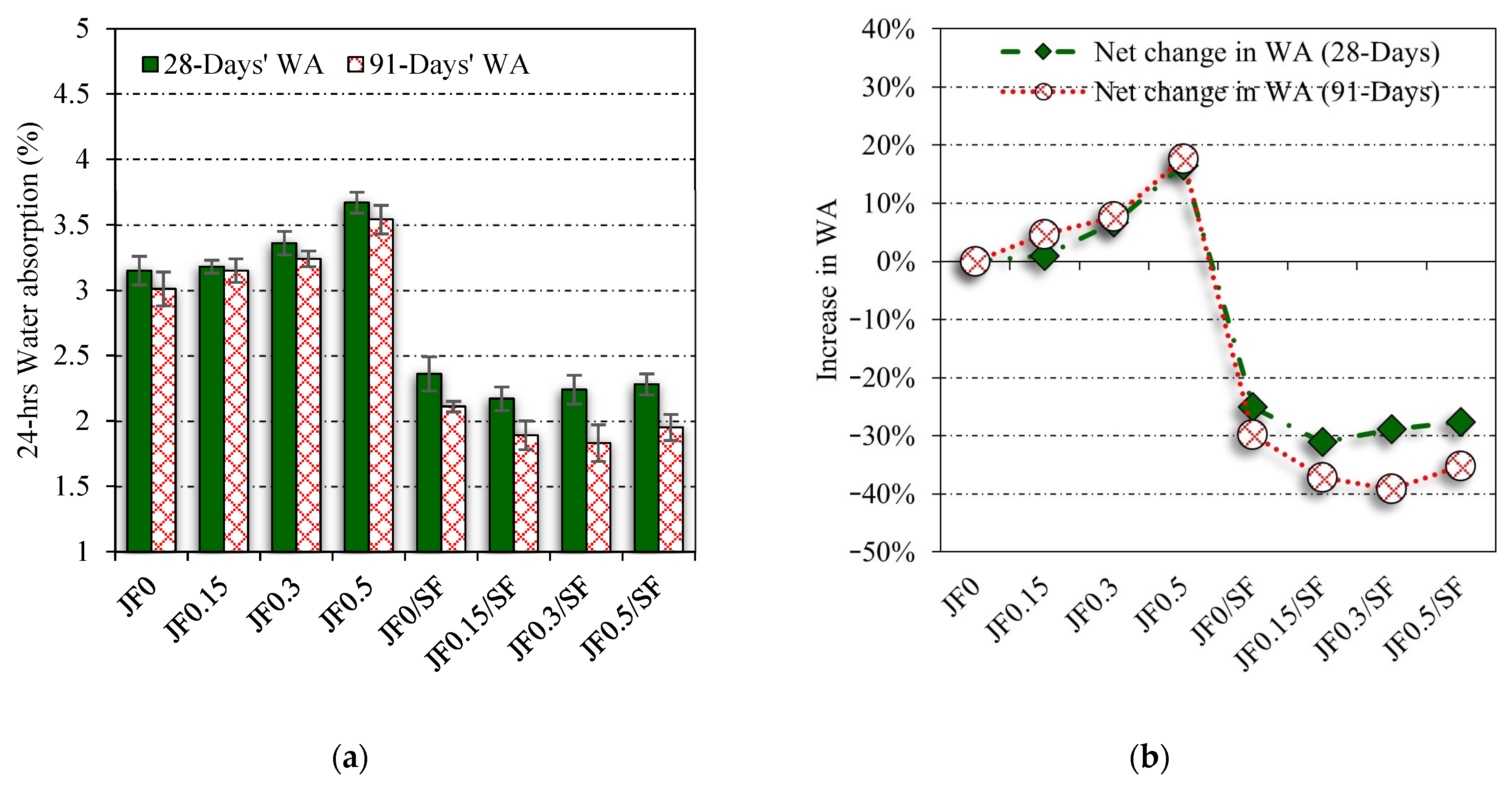
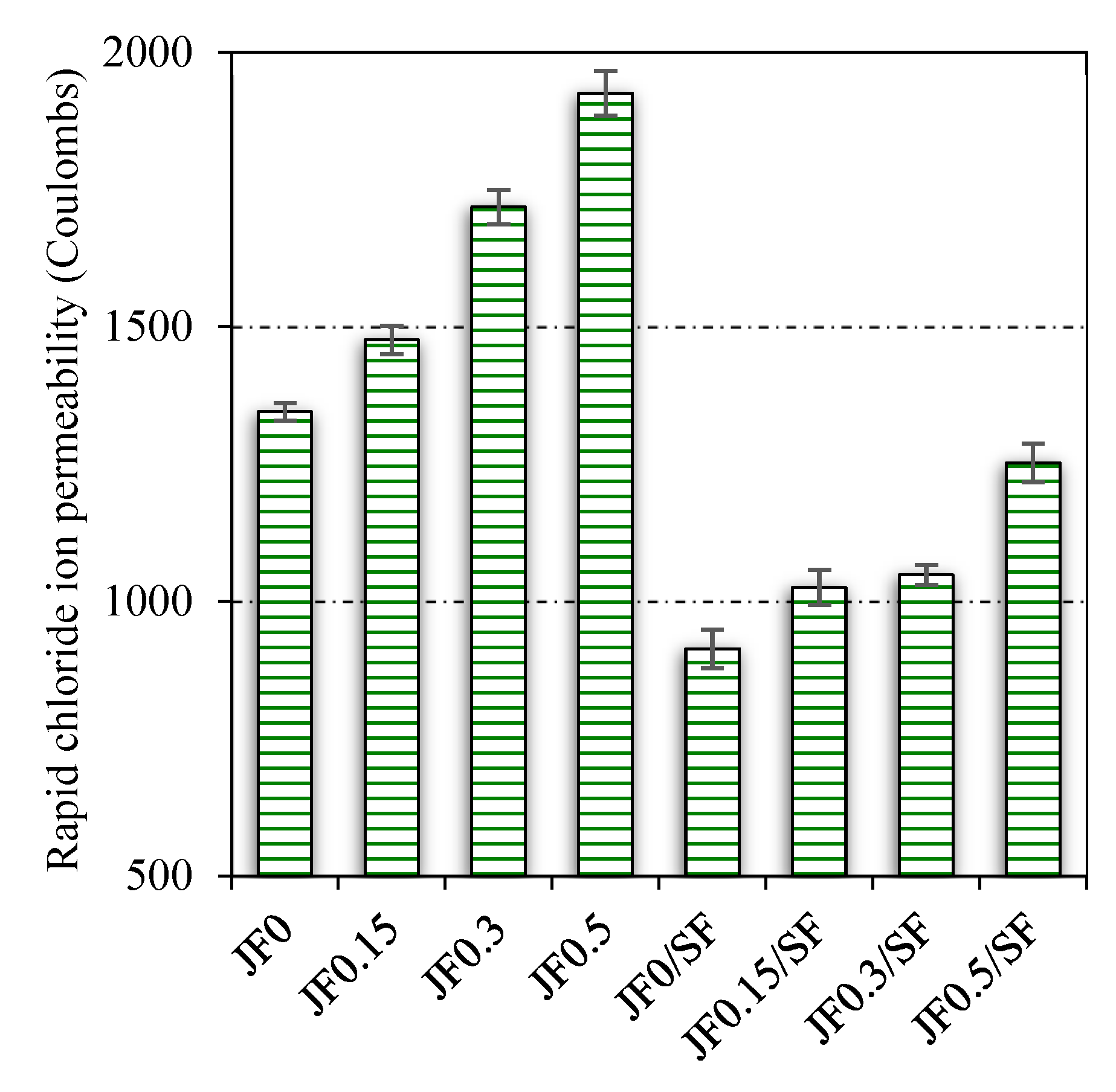
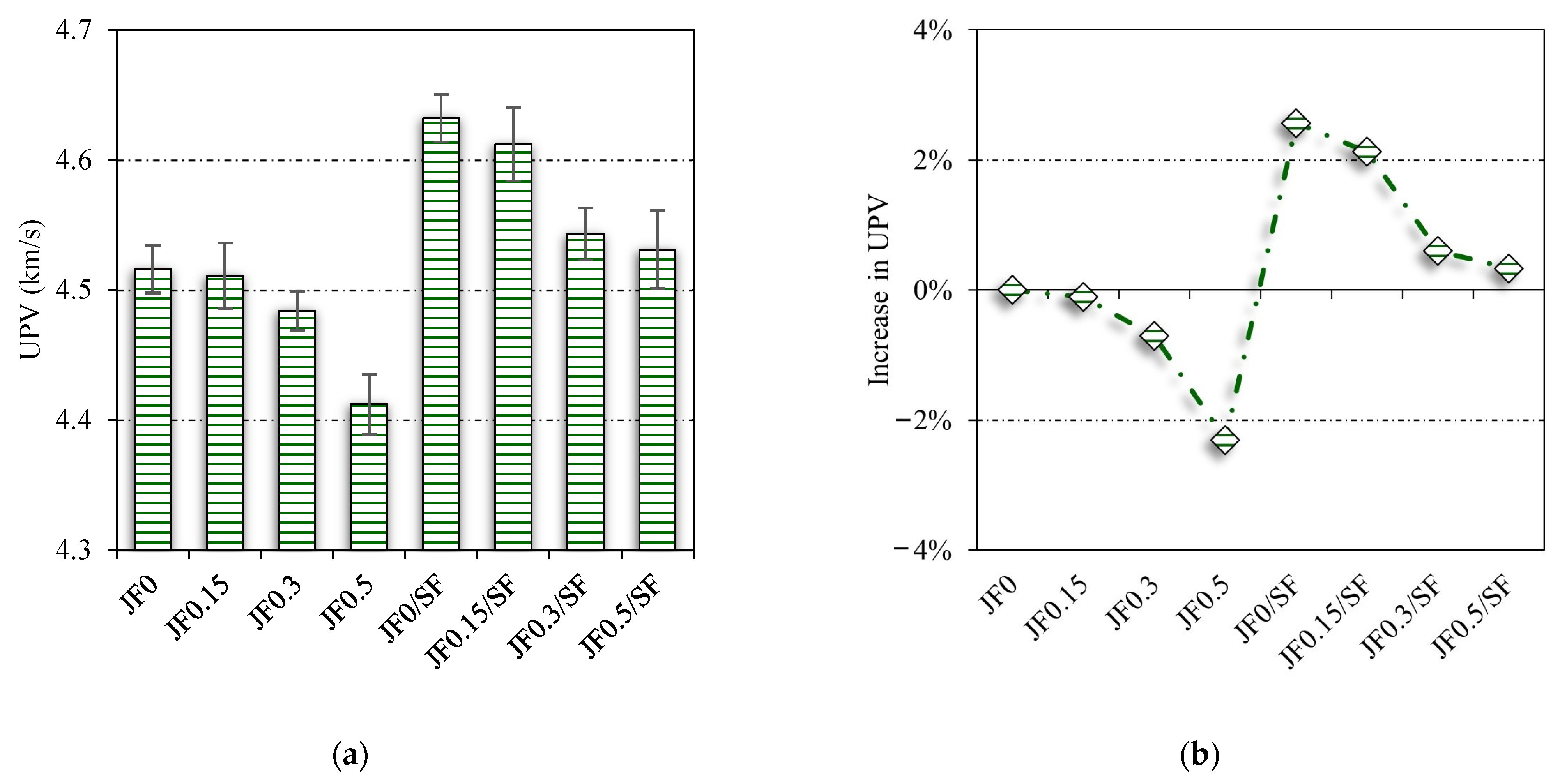
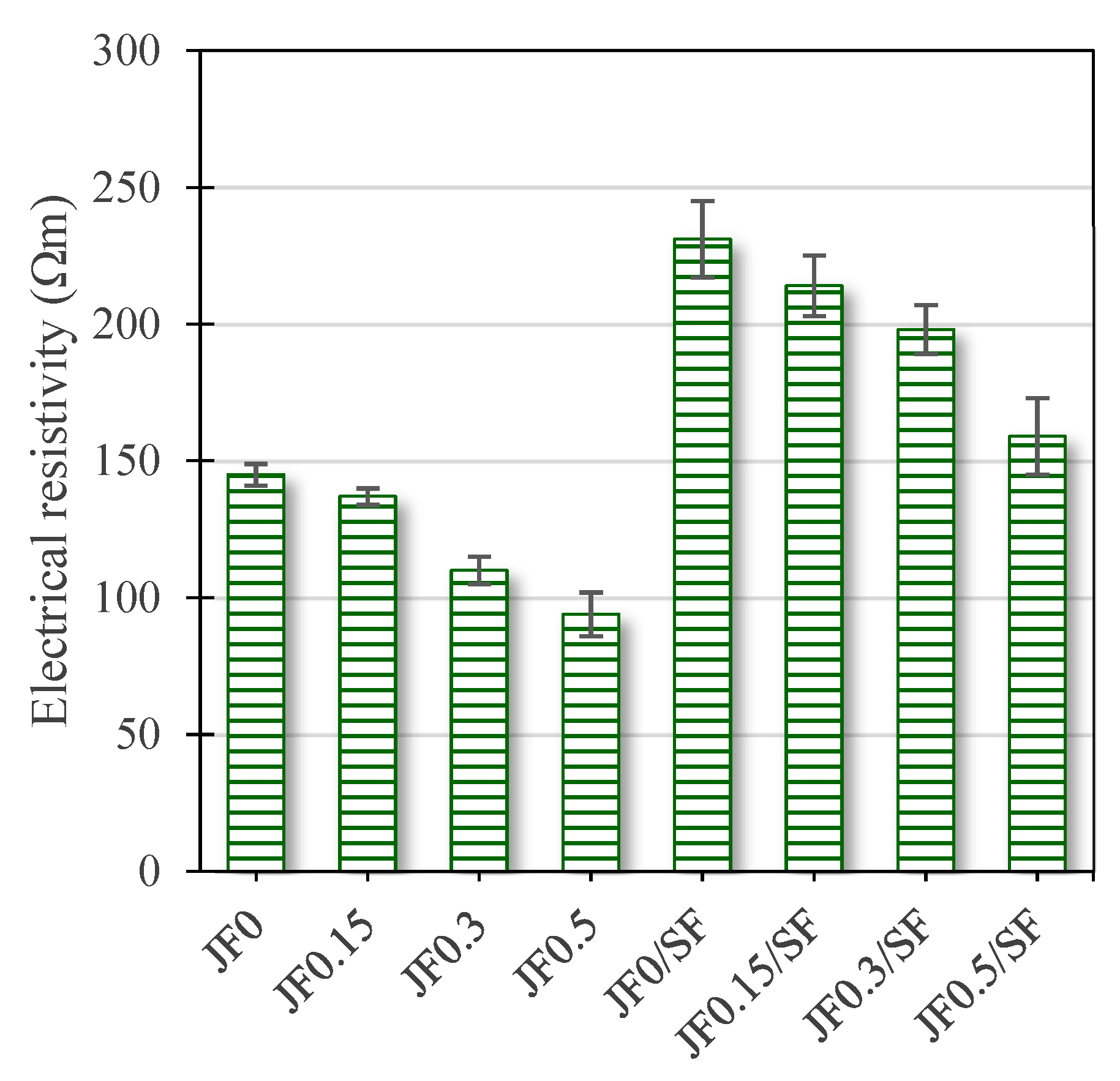
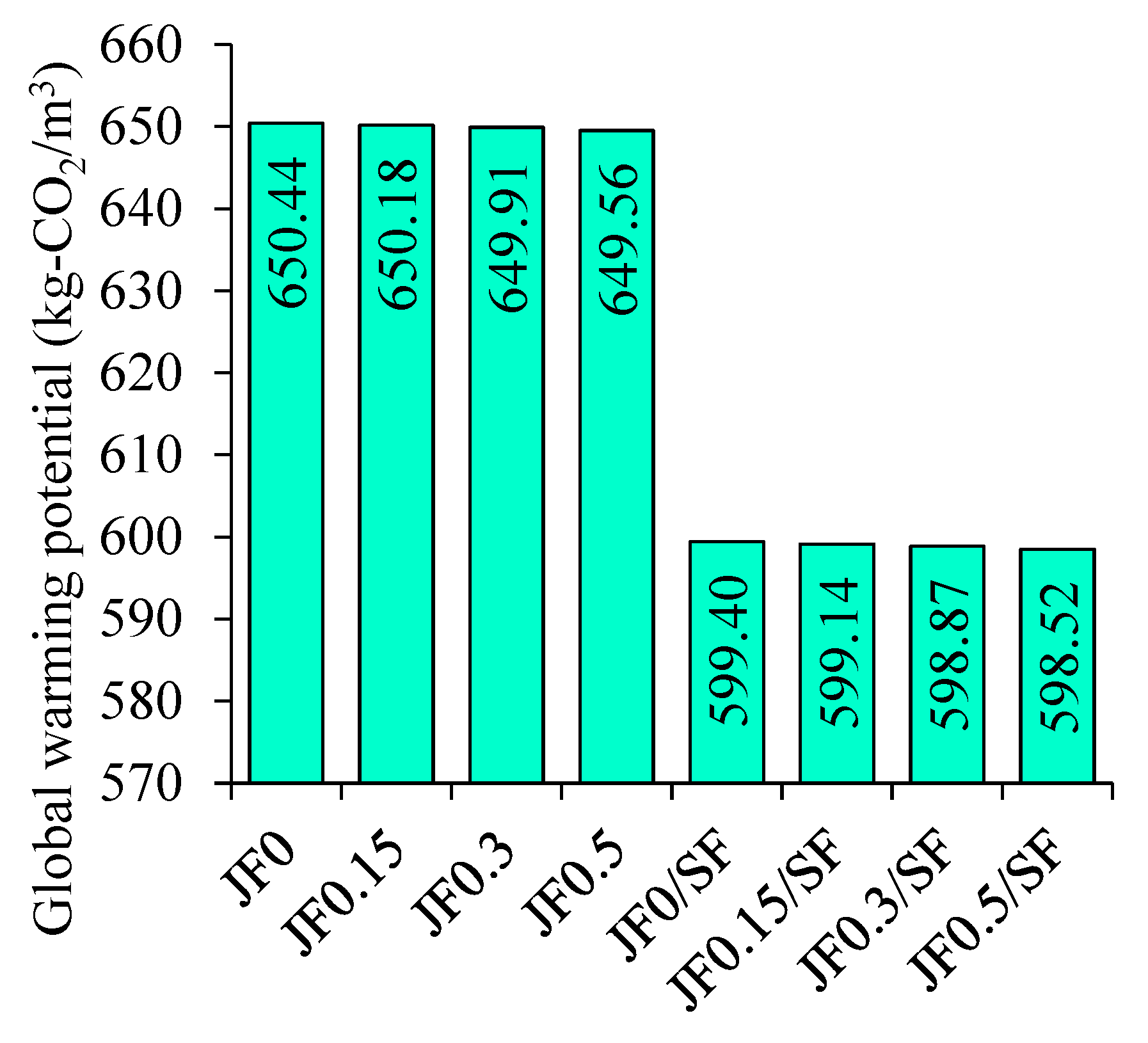
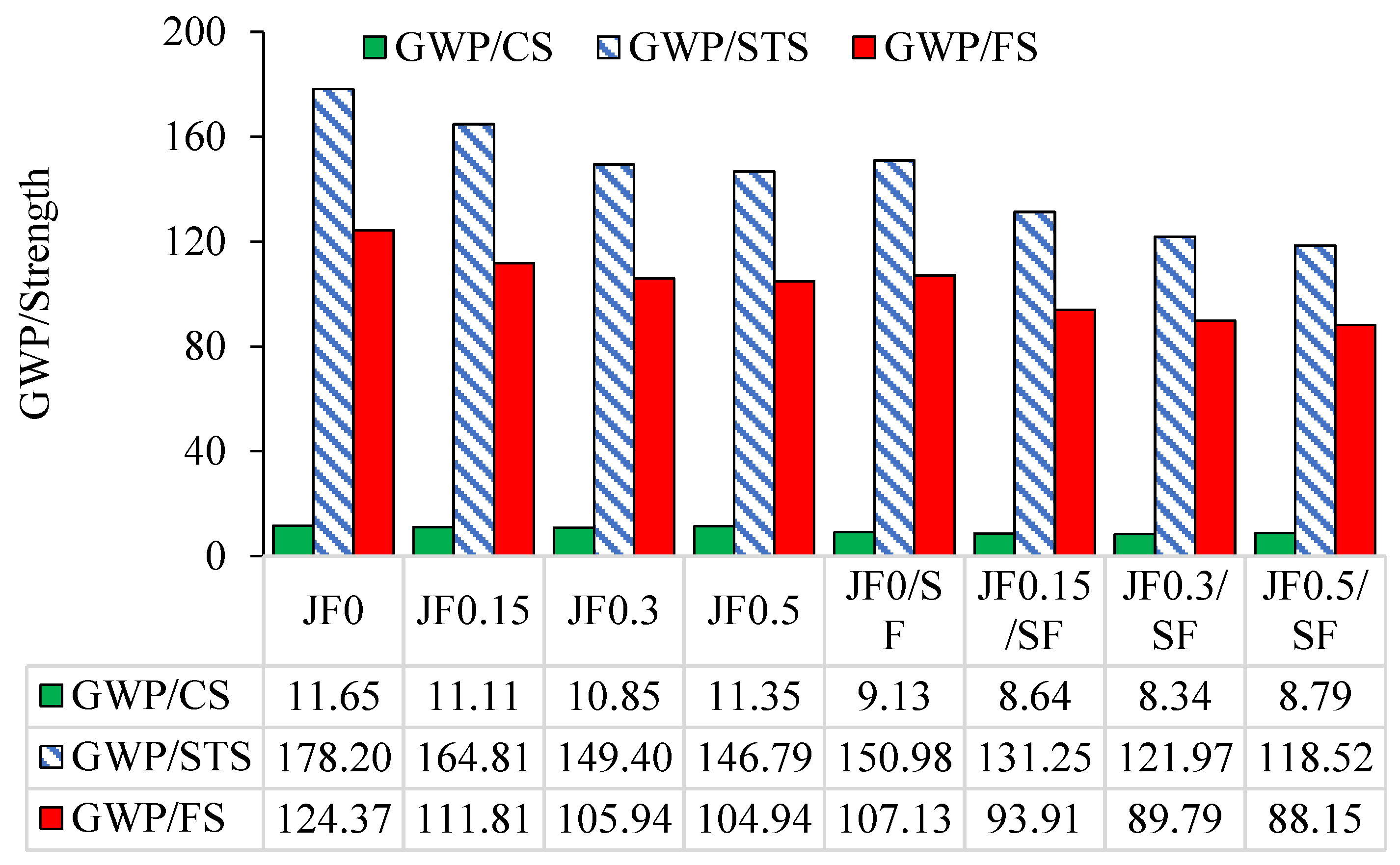
| Oxide | (%) |
|---|---|
| SiO2 | 17.44 |
| CaO | 65.17 |
| Al2O3 | 4.61 |
| MgO | 2.16 |
| Mix Names | JF (%) | Type I Cement (kg/m3) | SF (kg/m3) | Fine Aggregate (kg/m3) | Coarse Aggregate (kg/m3) | Water (kg/m3) | SP (kg/m3) | JF (kg/m3) |
|---|---|---|---|---|---|---|---|---|
| JF0 | 0 | 550 | 0 | 640 | 1073 | 182 | 3.03 | 0.00 |
| JF0.15 | 0.15 | - | 0 | - | - | - | - | 2.16 |
| JF0.3 | 0.3 | - | 0 | - | - | - | - | 4.32 |
| JF0.5 | 0.5 | - | 0 | - | - | - | - | 7.20 |
| JF0/SF | 0 | 495 | - | - | - | - | - | 0.00 |
| JF0.15/SF | 0.15 | - | - | - | - | - | - | 2.16 |
| JF0.3/SF | 0.3 | - | - | - | - | - | - | 4.32 |
| JF0.5/SF | 0.5 | - | - | - | - | - | - | 7.20 |
| Material | GWP (kg-CO2/kg) |
|---|---|
| OPC | 0.898 |
| Siliceous sand | 0.002 |
| Dolomite sandstone | 0.053 |
| SP | 0.002 |
| Water | 0.000 |
| SF | 0.0011 |
| JF | 0.36 |
| Concrete preparation | 4.65 |
| Transportation impact | 0.0000657 |
| Material | Distance from Mixing Plant (km) |
|---|---|
| OPC | 397 |
| SF | 178 |
| Siliceous sand | 456 |
| Dolomitic sandstone | 246 |
| SP | 177 |
| JF | 15 |
| Water | 0 |
Disclaimer/Publisher’s Note: The statements, opinions and data contained in all publications are solely those of the individual author(s) and contributor(s) and not of MDPI and/or the editor(s). MDPI and/or the editor(s) disclaim responsibility for any injury to people or property resulting from any ideas, methods, instructions or products referred to in the content. |
© 2023 by the author. Licensee MDPI, Basel, Switzerland. This article is an open access article distributed under the terms and conditions of the Creative Commons Attribution (CC BY) license (https://creativecommons.org/licenses/by/4.0/).
Share and Cite
Kurda, R. Effect of Silica Fume on Engineering Performance and Life Cycle Impact of Jute-Fibre-Reinforced Concrete. Sustainability 2023, 15, 8465. https://doi.org/10.3390/su15118465
Kurda R. Effect of Silica Fume on Engineering Performance and Life Cycle Impact of Jute-Fibre-Reinforced Concrete. Sustainability. 2023; 15(11):8465. https://doi.org/10.3390/su15118465
Chicago/Turabian StyleKurda, Rawaz. 2023. "Effect of Silica Fume on Engineering Performance and Life Cycle Impact of Jute-Fibre-Reinforced Concrete" Sustainability 15, no. 11: 8465. https://doi.org/10.3390/su15118465
APA StyleKurda, R. (2023). Effect of Silica Fume on Engineering Performance and Life Cycle Impact of Jute-Fibre-Reinforced Concrete. Sustainability, 15(11), 8465. https://doi.org/10.3390/su15118465






